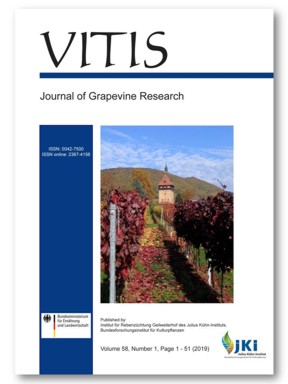Stem starch reserves studied by on-solid reactions coupled with reflectance detections in water stressed grapevines
DOI:
https://doi.org/10.5073/vitis.2019.58.47-51Keywords:
drought; stain; wood reserves; starch-iodine complexation; water potential; non-structural carbohydrates.Abstract
Wine grape is usually grown under water deficit conditions that could negatively impact plant reserves, including the organic carbon storage in perennial organs such as woody stems. Assessing the carbohydrate status in woody organs is therefore of interest as it can influence vegetative growth in the successive season. In this study, we aimed to apply an on-solid colour reaction (using Lugol's iodine solution) coupled with reflectance spectroscopy detection to assess the grapevine canes' starch accumulation in response to short drought periods. We used two Vitis vinifera cultivars ('Cabernet Sauvignon' and 'Syrah') that were subjected to three different water conditions (well-watered; early water stress; late water stress) during the growing season as case study. We sampled woody stem tissue during winter rest. The results showed that water stress reduced the starch storage in 'Syrah', especially when imposed late and recovery time was not enough for carbon restoration, while 'Cabernet Sauvignon' was not affected. The results showed that the sensitivity of the method used here is adequate to assess starch accumulation differences due to drought treatments in grapevine canes. Moreover, the analytical approach appears fast, low cost, and promising for future physiological and agronomical research applications.
Downloads
Published
Issue
Section
License
The content of VITIS is published under a Creative Commons Attribution 4.0 license. Any user is free to share and adapt (remix, transform, build upon) the content as long as the original publication is attributed (authors, title, year, journal, issue, pages) and any changes to the original are clearly labeled. We do not prohibit or charge a fee for reuse of published content. The use of general descriptive names, trade names, trademarks, and so forth in any publication herein, even if not specifically indicated, does not imply that these names are not protected by the relevant laws and regulations. The submitting author agrees to these terms on behalf of all co-authors when submitting a manuscript. Please be aware that this license cannot be revoked. All authors retain the copyright on their work and are able to enter into separate, additional contractual arrangements.



